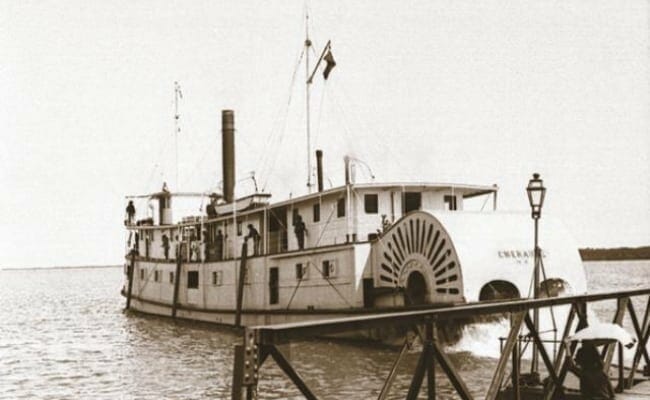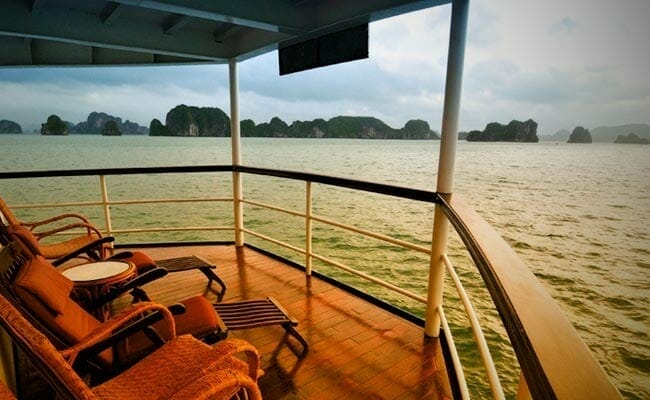One of the great natural wonders of the world and a UNESCO World Heritage Site, Halong Bay covers an area of 1,500 km over which are scattered thousands of limestone islands and grottoes rising from the clear, emerald waters of the Gulf of Bac Bo. The majestic beauty of the bay and its islands is only fully appreciated while meandering among the islands, fjords and inlets.
After a night on board the Emeraude, passengers awaken to see daylight filtering through the early morning mist and the towering rock formations, leaving them with a dream-like memory of their visit to Halong Bay.
The History of Emeraude Cruise

Stepping onto the Emeraude is as transporting as time travel. And the vessel’s history is as captivating as a fine old yarn.
The Postcard
In 1999, a young French entrepreneur Eric Merlin was rummaging in the St. Ouen flea market in Paris, looking – as was his habit – for anything old with links to Vietnam and Indochina.
On this day, he found three postcards, dated 1916, 1917 and 1919. Two pictured paddle steamers in Halong Bay. A third showed a steamer at port in nearby Haiphong. A magnifying glass revealed the name of one of the vessels, the “Emeraude”.
For some time, the cards lay in Eric’s desk in Paris. From time to time, he took them out and showed them to friends. He dreamed of finding the old vessels. Later, as those prospects dimmed, a new dream took sail.
He’d rebuild one of the old paddle steamers. 
The vision was far more than mere homage. He planned to launch the boat on Halong Bay. The realisation would conjure, not just a much missed means of transport, but a lost era of glamour, romance and discovery.
Despite excellent connections and an impressive track record at a successful Vietnam-based travel company, Exotissimo, he found himself unable to attract investors. No matter. In January 2003, with postcards as the only guide, he commissioned boat builders to bring back the Emeraude.
The Search
While the boat took shape in a shipyard, Eric began a quest for more information.
The search spanned continents and featured a number of false trails. Briefly, he believed the boats had sailed between England and France as mail boats, a theory promoted by information on an Australian stamp club website. The British Maritime Museum dispelled that story.
Meanwhile counterparts in Paris came up with another picture that matched his paddle steamer postcards, and Eric pressed on. When he learned that many of Indochina’s historical documents ended up in an archive in Aix en Provence in the South of France, he hired a school teacher to carry on the search.
Soon, the information was coming in thick and fast. The Emeraude was part of a fleet managed by the barge and towing company SACRIC (Société Anonyme de Chalandage et Temorquage de l’Indo-Chine). Its owner was a Monsieur Paul Roque. Instinctively, Eric knew the Roque family was his best bet for information.
Working from Vietnam he found a French Telephone Directory containing 1,220 Roques. He drafted a letter to send to every one of them.
He told them of his flea market find and enclosed a photocopy of the postcards. He outlined the information found to date and asked, ‘Are you the Roques we’re looking for?’
 His staff in Vietnam helped put the letters in envelopes and address them all with stickers. He then carried the 10kg box back to France and stamped them in a small sleepy village where he was staying on holiday. The tiny post office had never seen so much mail.
His staff in Vietnam helped put the letters in envelopes and address them all with stickers. He then carried the 10kg box back to France and stamped them in a small sleepy village where he was staying on holiday. The tiny post office had never seen so much mail.
And then the calls came. Maddeningly, the first twenty or so were of no help at all. They’d called to say yes, Roque was their name, what a lovely story. But they weren’t the Roques he was looking for.
One couple said they’d recently visited Vietnam on holiday if that helped. It didn’t.
And then the call he was waiting for finally came.
“Look no further,” the voice said. “I am the grandson of Paul Roque.”
Excited, Eric travelled to Paris as soon as he could.
And there, right in the middle of the sizeable Roque family apartment, was a large antique model of The Emeraude. Eric could hardly believe it.
That wasn’t all. Among the many mementoes of a bygone colonial era was the original china from the boats. Silverware too. There was even a 100-year-old staff uniform.
The Roque Brothers
Paul Roque, who launched the Emeraude, was the second generation of his family in Indochina. Initially, there had been three adventuring brothers – Victor, Xavier and Henry – who embarked from Bordeaux in 1858.
After a stop in Manila, they moved onto Hong Kong where they established themselves as suppliers to the French Army. When the troops of Admiral Rigault de Genouilly took Saigon, they followed in 1860.
Against this historic backdrop their empire grew. Sugar, opium, timber, public works, steamships. The list was long.
Now rich and famous, they were targeted by Chinese pirates. In 1890, the notorious Luu Ky and his men kidnapped and tortured two of the brothers.
Paying the ransom meant selling off many of their assets and Victor, by this time 61, left for home near-bankrupt and in poor health.
Henry assumed control but was soon joined by Paul, son of Xavier. They scaled their business back to concentrate on the North and, in particular, Haiphong and Halong Bay.
There they had the idea to build a small fleet of five “paddle wheeler” ships that would double as cargo and cruise vessels. They’d be called – the Rubis, the Perle, the Saphir, the Onyx and the Emeraude.
Though down on their luck, the Roques invested heavily in the boats.
They came to the conclusion, as Eric did almost a century later, that there was a market for a little luxury on Halong Bay.
So they ensured the boats had electric lights. They installed ventilation and refrigeration. They included darkrooms for the many photographers who were inspired by the scenery. And the Emeraude set sail.
Paul Roque returned to Paris in 1921, the last of his family to leave Asia after more than six decades. The Emeraude steamed on.
Years later, on the evening of March 16, 1937, as the Emeraude was returning to Haiphong, it collided with a submerged rock. The collision ripped a large hole in the shell of the vessel and it quickly sank.
Incredibly, according to the police report, all those aboard were saved. However, the Emeraude was never recovered.
Following their defeat at the decisive battle of Dien Bien Phu in 1954, the French finally left Vietnam and SACRIC folded. Paul Roque died in 1966.
The French colonial era was over, and the Emeraude was at the bottom of the sea.
Renaissance
Eric’s Emeraude was built locally in Haiphong to international standards but very much in keeping with the original design. In December 2003, the namesake of the glorious old vessel set sail.
While the original was split between cargo and cruisers the new Emeraude is exclusively a leisure vessel. The paddle wheel at the back echoes the design of the original but isn’t used for propulsion. Instead it opens up to provide a swimming deck for passengers.
Inside there are many photos of the original steamers that Eric has continued to find and now shares with passengers.
For Eric, however, it’s not quite the end of the story.
He still wants to find out what happened to those other paddle boats. He feels that surely such a large piece of metal as the original Emeraude can’t stay lost forever. Could divers locate it?
Meanwhile, he and his brother Jean-Marc continue to develop business in Vietnam, and across Southeast Asia. From scratch they’ve built up a portfolio of businesses in the Apple Tree Group that now employs over 2000 people.
They’ve restored a colonial era mansion as La Residence Hotel & Spa in Hue. They’ve refurbished a one-time home of Lao royalty as Villa Maly in Luang Prabang. They understand that stories fuel the romance of travel.
Meanwhile, the Emeraude, like its predecessor, spends its days cruising the turquoise waters of Halong Bay.
Fittingly, once more, under the watch of a French captain.
About Emeraude Cruise
Each bespoke cabin exudes warmth and character with high standards of work manship, distinguished style and impeccable service. With its polished wooden floors and brass fixtures and fittings the Emeraude’s rooms offer timeless elegance.
Emeraude is a 55m length steamer boat features 3 decks, 38 full view cabins & 1 suite, a 80-seat restaurant, 2 bars, shops, massage rooms, swimming platform, entertainment completion.
From the 350m2 open upper sun deck, passengers can enjoy a soothing foot massage while sipping a refreshing cocktail and gazing at the rock formations reflected in the crystal clear water of the bay. The Emeraude’s huge paddle wheel opens to reveal a swimming deck offering passengers the opportunity to swim in the calm waters of the bay surrounded by the majestic scenery. At dawn, that most magical time as the sun rises, the soft and graceful movements of a Tai chi class on.
Restaurant and Bars : The Emeraude’s restaurant offers delicious, freshly caught local seafood and other specialities. While enjoying breathtaking views of the bay, passengers can enjoy the simple and honest flavours of traditional fare.
From the sun deck, passengers can enjoy a soothing foot massage while sipping a refreshing cocktail and gazing at the rock formations reflected in the crystal clear water of the bay. The Emeraude’s huge paddle wheel opens to reveal a swimming deck offering passengers the opportunity to swim in the calm waters of the bay surrounded by the majestic scenery. At dawn, that most magical time as the sun rises, the soft and graceful movements of a t’ai chi class on the deck complement the atmospheric silence of the bay.






